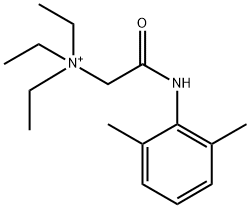QX 314 chloride
Synonym(s):N-(2,6-Dimethylphenylcarbamoylmethyl) triethylammonium chloride
- CAS NO.:5369-03-9
- Empirical Formula: C16H27ClN2O
- Molecular Weight: 298.85
- MDL number: MFCD01669894
- SAFETY DATA SHEET (SDS)
- Update Date: 2024-11-20 11:41:24

What is QX 314 chloride?
The Uses of QX 314 chloride
QX 314 chloride is a membrane-impermeant lidocaine derivative that selectively blocks sodium channels on nociceptive neurons when delivered intracellularly via the TRPV1 channel, but is reportedly ineffective with extracellular application. When supplied in combination with 1 μM capsaicin , a TRPV1 receptor agonist, 5 mM QX-314 blocks 98% of sodium current in voltage-clamped nociceptive DRG neurons. QX 314 chloride elicits a long-lasting decrease in the response to painful mechanical and thermal stimuli without imparting the motor deficits (e.g., numbness, paralysis) associated with many conventional local anesthetics. At concentrations ranging from 10-70 mM, peripheral application of QX 314 chloride dose-dependently produces robust local anesthesia with slow onset in the guinea pig intradermal wheal assay, the mouse tail-flick test, and the mouse sciatic nerve blockade model.
The Uses of QX 314 chloride
QX 314 Chloride has been shown to have antitussive properties in mammalian animal models.
What are the applications of Application
QX 314 chloride is a voltage-activated Na+ channel blocker
Biological Activity
Membrane impermeable quaternary derivative of lidocaine, a blocker of voltage-activated Na + channels.
Biochem/physiol Actions
Lidocaine N-ethyl chloride is an intracellular voltage-gated sodium channel blocker.
storage
Room temperature
Properties of QX 314 chloride
| Melting point: | 209-211 °C |
| storage temp. | Room temp |
| solubility | insoluble in EtOH; ≥14.95 mg/mL in DMSO with gentle warming; ≥22.3 mg/mL in H2O |
| form | solid |
| color | White |
| Water Solubility | Soluble in water (100mM) |
Safety information for QX 314 chloride
Computed Descriptors for QX 314 chloride
New Products
(S)-3-Aminobutanenitrile hydrochloride 4-Methylphenylacetic acid N-Boc-D-alaninol N-BOC-D/L-ALANINOL Tert-butyl bis(2-chloroethyl)carbamate 3-Morpholino-1-(4-nitrophenyl)-5,6-dihydropyridin- 2(1H)-one Furan-2,5-Dicarboxylic Acid Tropic acid S-2-CHLORO PROPIONIC ACID ETHYL ISOCYANOACETATE 2-Bromo-1,3-Bis(Dimethylamino)Trimethinium Hexafluorophosphate 4-IODO BENZOIC ACID 3-NITRO-2-METHYL ANILINE 1-(2,4-DICHLOROPHENYL) ETHANAMINE (2-Hydroxyphenyl)acetonitrile 4-Bromopyrazole 5,6-Dimethoxyindanone 2-(Cyanocyclohexyl)acetic acid 4-methoxy-3,5-dinitropyridine 1-(4-(aminomethyl)benzyl)urea hydrochloride 2-aminopropyl benzoate hydrochloride diethyl 2-(2-((tertbutoxycarbonyl)amino) ethyl)malonate tert-butyl 4- (ureidomethyl)benzylcarbamate Ethyl-2-chloro((4-methoxyphenyl)hydrazono)acetateRelated products of tetrahydrofuran

![2-[(2,6-DIMETHYLPHENYL)AMINO]-N,N,N-TRIMETHYL-2-OXOETHANAMINIUM CL](https://img.chemicalbook.in/CAS/GIF/21236-55-5.gif)



You may like
-
 Lidocaine N-ethyl chloride CAS 5369-03-9View Details
Lidocaine N-ethyl chloride CAS 5369-03-9View Details
5369-03-9 -
 2033-24-1 98%View Details
2033-24-1 98%View Details
2033-24-1 -
 1975-50-4 98%View Details
1975-50-4 98%View Details
1975-50-4 -
 2-HYDROXY BENZYL ALCOHOL 98%View Details
2-HYDROXY BENZYL ALCOHOL 98%View Details
90-01-7 -
 2-Chloro-1,3-Bis(Dimethylamino)Trimethinium Hexafluorophosphate 221615-75-4 98%View Details
2-Chloro-1,3-Bis(Dimethylamino)Trimethinium Hexafluorophosphate 221615-75-4 98%View Details
221615-75-4 -
 61397-56-6 CIS BROMO BENZOATE 98%View Details
61397-56-6 CIS BROMO BENZOATE 98%View Details
61397-56-6 -
 14714-50-2 (2-Hydroxyphenyl)acetonitrile 98+View Details
14714-50-2 (2-Hydroxyphenyl)acetonitrile 98+View Details
14714-50-2 -
 118753-70-1 98+View Details
118753-70-1 98+View Details
118753-70-1